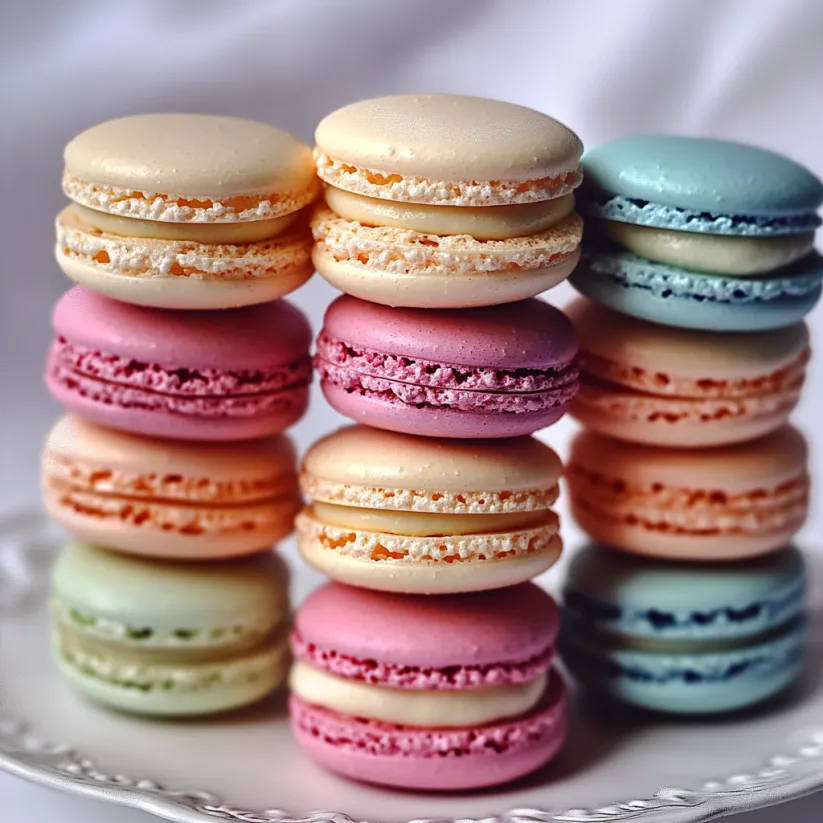 Save Pin
Save Pin
This beginner-friendly macaron recipe transforms the intimidating French classic into an approachable kitchen project that yields professional-looking results. With careful attention to a few key techniques, you'll create these delicate, colorful treats that look as impressive as they taste delicious.
I developed this recipe after failing countless times with overcomplicated methods. Now my daughter and I make these together monthly, turning what used to be a baking nightmare into our special bonding activity.
Ingredients
- Almond flour high quality finely ground almond flour creates the distinctive texture and flavor of macarons
- Powdered sugar combines with the almond flour to create the dry mixture that gives macarons their structure
- Egg whites the protein in room temperature egg whites creates the meringue that gives macarons their lift
- Granulated sugar stabilizes the egg whites and adds sweetness to balance the almond flavor
- Gel food coloring provides vibrant color without adding excess moisture that can ruin the batter consistency
- Unsalted butter creates a smooth creamy filling that complements the crisp shell perfectly
- Vanilla extract adds depth to the filling but can be substituted with any flavor you prefer
Step-by-Step Instructions
- Prepare the Dry Ingredients
- Sift almond flour and powdered sugar together multiple times to eliminate any lumps or coarse pieces. This tedious step is absolutely crucial for achieving that signature smooth macaron top. Take your time here as rushing will lead to bumpy uneven shells.
- Beat the Egg Whites
- Start with room temperature egg whites in an impeccably clean bowl with no trace of grease or water. Begin whisking at medium speed until foamy then gradually increase speed while slowly adding granulated sugar. Continue beating until stiff glossy peaks form that stand straight up when you lift the beater. The meringue should look like shaving cream and feel smooth between your fingers with no sugar granules remaining.
- Combine Wet and Dry Ingredients
- This is the most technical part of the process. Add the dry ingredients in two batches using the macaronage technique folding gently from the bottom up and rotating the bowl. The perfect consistency is reached when the batter flows like thick ribbon and a figure eight drawn with the batter disappears within 15 seconds. Count your folds and stop frequently to check consistency.
- Pipe the Macarons
- Hold your piping bag perpendicular to the baking sheet and apply even pressure to create consistent circles. Use a template under your parchment paper if needed for uniform sizing. Release pressure then make a quick flick to avoid peaks. Proper spacing prevents shells from running together during baking.
- Rest the Shells
- The resting period allows a skin to form on top of the piped macarons which is essential for developing feet during baking. In humid environments this might take longer than the recommended time. Test by gently touching the surface your finger should come away clean with no batter sticking.
- Bake the Shells
- Bake in a preheated oven at exactly 300°F checking the position of your oven rack and using an oven thermometer for accuracy. Proper temperature ensures even rising and perfect feet formation. Bake one tray at a time for consistent results rotating halfway through baking.
 Save Pin
Save Pin
The first time I made these successfully after multiple failures I actually shed tears of joy. My daughter now says she can taste the love in each batch particularly when we use our special vanilla extract from Madagascar that adds a complexity none of our guests can quite identify.
Troubleshooting Tips
Hollow shells often result from undermixed batter or baking temperature that is too high. Make sure your oven is properly calibrated and that you fold the batter to the right consistency.
Cracked tops typically indicate insufficient resting time or too much moisture in your ingredients. Always let your shells form a skin before baking and avoid making macarons on particularly humid days.
No feet development usually means your batter was too wet or you did not rest the shells long enough. The dry skin that forms during resting is essential for proper feet formation during baking.
Flavor Variations
The basic shell recipe provides a perfect canvas for endless flavor possibilities. Add extracts to the shell batter during the meringue stage or create flavored fillings by incorporating fruit preserves chocolate ganache or nut butters into the basic buttercream.
For chocolate macarons substitute 2 tablespoons of the almond flour with unsweetened cocoa powder. For citrus variations add finely grated zest to the dry ingredients. Experiment with spices like cinnamon cardamom or matcha powder for unique flavor profiles.
Storage Advice
Store filled macarons in an airtight container in the refrigerator for optimal texture and flavor development. The moisture from the filling will gradually soften the shells creating that perfect chewy interior while maintaining the crisp exterior.
Bring refrigerated macarons to room temperature for 15 to 20 minutes before serving to fully enjoy their flavor and texture. For longer storage freeze in single layers separated by parchment paper for up to a month and thaw in the refrigerator before bringing to room temperature.
 Save Pin
Save Pin
Commonly Asked Questions
- → Why do my macarons crack during baking?
Cracking usually occurs when shells haven't dried sufficiently before baking. Ensure you let piped shells rest until they form a dry skin on top (30-60 minutes depending on humidity). Oven temperature that's too high can also cause cracking, so consider using an oven thermometer to verify accuracy.
- → How do I know when my macaron batter is properly mixed?
The perfect macaron batter has a 'lava-like' consistency. When lifted with a spatula, it should flow like a ribbon and reincorporate back into the remaining batter within 10-15 seconds. If it disappears immediately, it's overmixed; if it stays as a mound, it needs more folding.
- → Can I make macarons without almond flour?
Traditional macarons require almond flour for their characteristic texture and flavor. While other nut flours (like hazelnut or pistachio) can work as substitutes, non-nut alternatives generally won't produce authentic results. The fine texture and natural oils in almond flour are essential to proper shell formation.
- → Why should macarons mature in the refrigerator?
The maturation period allows moisture from the filling to slightly soften the shells, creating that perfect chewy-crisp texture balance. This resting time also helps flavors meld together and develop complexity. While you can eat macarons immediately after assembly, their texture and taste improve significantly after 24-48 hours of refrigeration.
- → What's the difference between French and Italian macaron methods?
The French method (used in this guide) involves folding dry ingredients into a French meringue (whipped egg whites with sugar). The Italian method uses a hot sugar syrup poured into egg whites to create a more stable Italian meringue before adding dry ingredients. The French method is simpler for beginners but can be more finicky, while the Italian method is more stable but requires handling hot sugar syrup.
- → How can I add different flavors to my macarons?
The best way to add flavor is through the filling rather than the shells. For shell flavoring, use dry ingredients like cocoa powder or espresso powder (replacing some of the powdered sugar) or concentrated flavor extracts. The filling offers more flexibility—try different extracts, fruit purees, chocolate ganache, or even citrus zest for various flavor profiles.
